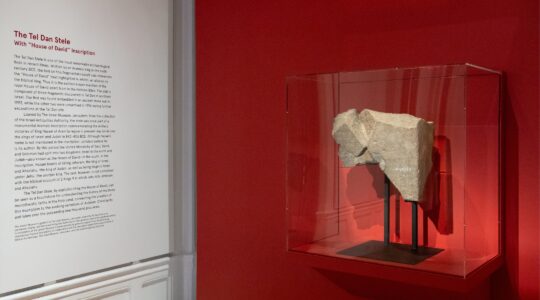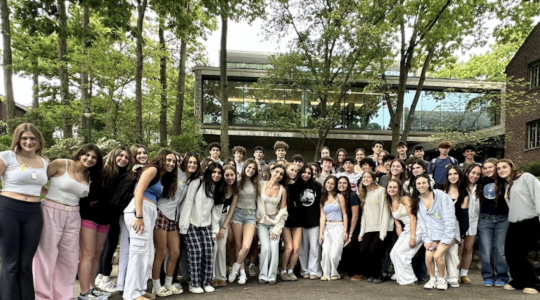Grodno, Belarus — Tsilia Brido remembers her early Belarus Passover in her Polotsk hometown, her grandfather leading the seders in Hebrew, women from the neighborhood baking their matzahs in her family’s large wood stove.
“It was before the war,” she says, referring to World War II. Belarus was the first of the former Soviet Union’s republics to be invaded by the German army.
Brido remembers the seders ending after 1941, first under the Nazis, then under the communists.
“After the war, it was not allowed,” says the widow with flaming red hair and a teenager’s spirit.
She remembers returning to seders in 1988, in the early years of the liberalization under President Mikhail Gorbachev, first in Grodno’s synagogue, then in sites rented by the city’s Orthodox community.
On Saturday night she went again.
In a city that was home to one of the former Pale of Settlement’s most prominent Jewish communities; in a republic that became independent when the USSR collapsed in 1991; in a society that is gearing up to commemorate the 60th anniversary of the end of what the ubiquitous signs call “The Great Patriotic War,” Brido, 75, joined more than fellow Grodno Jews the first night of Passover at a community seder at the Culinary Institute, a small school in the center of this city.
At daytime and nighttime seders at the institute, the Choral Synagogue and the headquarters of the Chesed social services agency, and at some private homes, members of the Jewish community read from the Haggadah and shared pieces of matzah.
Grodno was unusually cold, a winter chill descending on the city for the springtime holiday. “One-hundred twenty heroes” attended the seder in the Choral Synagogue, sitting at a long table in the cavernous, empty, unheated sanctuary.
“Everyone who came is a hero,” said Boris Kviatovsky, chairman of the Jewish Religious Community of Grodno.
Like last year, several hundred Jews participated in seders this year, said Yael Kalcheim, desk director for Belarus of the American Jewish Joint Distribution Committee, which finances the Chesed activities.
“Pesach is the main holiday that people remembered, even people in their 50s,” who grew up without any formal Jewish education, Kalcheim said.
Support the New York Jewish Week
Our nonprofit newsroom depends on readers like you. Make a donation now to support independent Jewish journalism in New York.
As throughout the former Soviet Union and the once-communist countries of Eastern Europe, many of the seders here were remedial, teaching the Jews what they had forgotten or never learned.
For the participants, the seders were a chance to dress up and socialize in a Jewish atmosphere. The men attended with their chests bedecked with WWII medals.
“We were looking for Jewish people,” Brido, a retired druggist, said of her reasons for returning to seders with her friends when they became available and legal. “I wanted to feel Jewish again.”
For Chesed, which sponsors an array of educational programs, the seders are a chance to serve its Jewish clients, using registration as a way to find out who are Grodno’s Jews and what they need.
For YUSSR, the Yeshiva University-based organization that sends two dozen volunteers each year to lead seders in Belarus and Germany, they were a chance to publicize the annual camps it sponsors for children.
Grodno had a majority Jewish population for centuries. This industrial city of 300,000 in western Belarus, on the banks of the Neiman River, was 40 percent Jewish on the eve of the Holocaust.
Today its estimated Jewish population is 1,500 in a country with 30,000 Jews among a total population of 10 million.
The Joint Distribution Committee, working through local organizations, has identified Jews in some 60 towns and villages. Sometimes it’s as few as a handful of Jews.
The Jewish community, weakened as all Belarusans by the government’s still-socialist economic policies that discourage private enterprise, is largely dependent on assistance from foreign Jewish organizations.
The Jewish Agency offers classes and other events with a Zionist orientation that promote aliyah. The Ronald S. Lauder Foundation sponsors several schools and the Lech Lecha Youth Center in Minsk, the capital.
The JDC, which returned to Belarus in 1991, holds leadership training sessions to help wean the community from outside help. The Reform movement also has a presence — Rabbi Grisha Abramovich, who was ordained by London’s Leo Baeck College, led separate model seders for children and adults before setting out for holiday celebrations elsewhere in the country.
YUSSR, which raises its own budget, comes here every Nissan.
Support the New York Jewish Week
Our nonprofit newsroom depends on readers like you. Make a donation now to support independent Jewish journalism in New York.
The seders I joined at the Culinary Institute were led by Joey Small, a Yeshiva University senior, and Serena Hefter, a Stern College sophomore. The first seder was mainly for senior citizens; families with children were invited the second night.
The hall in the institute was unheated.Using games and theatrics, conducting the seders in English and Russian, distributing plague toys and prizes (donations from J. Levine Judaica of Manhattan and Congregation Tiferes Yisroel in Baltimore), Small and Hefter worked the crowd like politicians. They greeted the crowd at the door in simple Russian, wandered around the tables to schmooze and led rousing Hebrew songs. They had arrived a few days earlier to buy supplies and kasher the kitchen.
Sitting at Small’s side during the seders was Grigory Khosid, a Grodno-born Holocaust survivor who serves as a community activist and leader of the religious community.
After morning services the second day of Passover, Khosid stood outside the Choral Synagogue, the only synagogue building in the city still used as a synagogue. Built in the 16th century and rebuilt after a disastrous fire two centuries ago, it sits at the edge of a gorge that cuts through the hilly city. The exterior of the stone building, which was used as a roundup center by the Nazis for the region’s Jews and housed various businesses during communist times, is crumbling.
Upstairs, in a small room with flaking paint walls and bricked-up windows, where a minyan of elderly men in coats and caps prayed that morning across a makeshift mechitza from a few women, all heated by a small brick stove in the corner, the remains of a Mogen David are visible in the warped planks that line the ceiling.
The synagogue is under the auspices of Rabbi Yitzchak Kofman, a Connecticut-born Lubavitch emissary who serves as the city’s chief rabbi.
Pointing to a row of stones imbedded in the grass a few yards behind the synagogue, at one time a building’s foundation, Khosid said a small prayer house had been there before World War II. During the Nazi occupation, he knew about a forthcoming roundup, so Khosid said he snuck into the small building and climbed onto an empty space atop the ark, out of sight of the German soldiers who herded Jews into the crowded space.
“I saved my life — that was one of many times,” he said, offering that he also escaped from a train bound for Treblinka.
Khosid, who has maintained his Jewish practice despite decades under Nazi and communist regimes, is a fountain of knowledge about Grodno’s Jewish history and customs.
Though Belarus is north of Israel, Grodno Jews still face east — ostensibly toward Jerusalem — when they pray, he said.
“It’s a tradition,” he said, that was inherited from the Jews from Western countries — Grodno over the years welcomed refugees from the Inquisition and nearby pogroms — who had turned toward mizrach for prayers.
Actually, they faced southeast, Khosid said, to avoid praying in then direction of a church, now long gone, across the street.
Support the New York Jewish Week
Our nonprofit newsroom depends on readers like you. Make a donation now to support independent Jewish journalism in New York.
Steve Lipman’s visit to Belarus was supported by the American Jewish Joint Distribution Committee.
The New York Jewish Week brings you the stories behind the headlines, keeping you connected to Jewish life in New York. Help sustain the reporting you trust by donating today.




